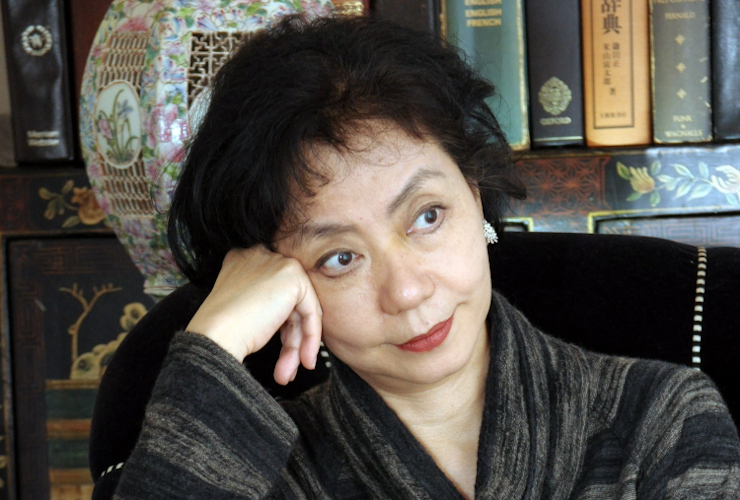An I-Novel
Minae Mizumura, translated by Juliet Winters Carpenter
Columbia University Press, $20 (paper)
From the novels of Ben Lerner to Rachel Cusk’s Outline trilogy (2014–2018) and Karl Ove Knausgaard’s multi-volume My Struggle (2009–2011), some of the most eye-catching literary fiction of recent years has been heavily autobiographical. The prototype of the modern autobiographical novel is generally considered to be Marcel Proust’s In Search of Lost Time (1913–1927). What is less widely known, here in the West, is that a very similar kind of novel came to prominence in early twentieth-century Japan. In 1907, a few years before the first volume of Proust’s opus saw the light of day, Katai Tayama published Futon, an autobiographical novella inspired by his unconsummated relationship with a female admirer and protégé. In 1912 Naoya Shiga published Ōtsu Junkichi, a fictionalized account of his affair with a family maid; he followed this up with 1917’s Wakai (Reconciliation), an introspective novel about his relationship with his father.
These were among the earliest examples of the shishōsetsu, or “I-novel,” a genre of confessional fiction in which the protagonist is generally understood to be the author. As with contemporary autofiction, these novels tend to emphasize subjectivity and interiority rather than descriptive realism or narrative artifice. In this respect the shishōsetsu differs from the honkaku shōsetsu, or “true novel,” which is more concerned with portraying characters and society in a realistic style. The scholar of East Asian literature Edward Fowler suggests that the I-novel should be regarded not so much as a genre but as a distinct literary form. The shishōsetsu, he explains, is “riddled with paradoxes”:
Supposedly a fictional narrative, it often reads more like a private journal. It has a reputation of being true, to a fault, to ‘real life’; yet it frequently strays from the author’s experience it allegedly portrays so faithfully. Its personal orientation makes it a thoroughly modern form; yet it is the product of an indigenous intellectual tradition quite disparate from western individualism.
This quality of being neither one thing nor the other makes shishōsetsu something of an acquired taste. In his curmudgeonly introduction to the Penguin Book of Japanese Short Stories (2018), Haruki Murakami declared himself “allergic” to the form. Another of Japan’s great literary exports, Yukio Mishima, disparaged confessional fiction as artless and self-indulgent—despite having started his own literary career with the shishōsetsu-adjacent autobiographical novel, Confessions of a Mask (1949). Critics of contemporary autofiction often express a similar ambivalence: detractors of Cusk and Knausgaard, in particular, have lamented what they see a narcissistic strain in their work. While the parallels with these authors are startling, Fowler is right to remind us that the shishōsetsu was neither a Western import nor a specifically twentieth-century invention, but rather the latest in a long tradition of confessional literature that stretches as far back as The Pillow Book, a diaristic hodgepodge of anecdotes and ruminations by the eleventh-century court lady Sei Shōnagon.
Japan’s literary tradition looms large in the work of the author Minae Mizumura. Though she received most of her education during a twenty-year stay in the United States—high school in Long Island, followed by college in Boston and postgrad at Yale—Mizumura harbored a lifelong passion for modern Japanese literature. She was in her thirties when she relocated to her native Tokyo and began writing fiction in Japanese. All three of her novels engage, either directly or allusively, with the Japanese literary canon: her 1990 debut, Zoku Meian (Light and Darkness Continued), was a sequel to—or rather, a completion of—Natsume Sōseki’s unfinished masterpiece, Meian (Light and Darkness); her third novel, a re-working of Emily Brontë’s Wuthering Heights set in postwar Japan, was entitled A True Novel (2002) in homage to the honkaku shōsetsu realist genre.
In between these Mizumura published Shishōsetsu from left to right (1995), a fictionalized account of her time in the United States, beginning with her teenage years and culminating in her decision to turn her back on the English language. Its publication in English as An I-Novel, courtesy of Juliet Winters Carpenter’s crisp translation and the Columbia University Press, constitutes a kind of homecoming: several decades on from that career-defining switch, Mizumura has returned, in a manner of speaking, to the East Coast. It is a timely publication: amid renewed interest in narratives of race and identity, Mizumura’s I-novel explores selfhood and belonging with a vivid, diaristic sincerity.
An I-Novel takes place on a single day in the 1980s, the twenty-year anniversary of the Mizumura family’s arrival in the United States. The novel’s narrator, Minae, and her sister, Nanae, immigrate aged twelve and fourteen respectively, when their father lands a job in New York. Nanae buys into U.S. youth culture—she adopts demotic English diction, peroxides her hair, and gets a Coppertone tan—but Minae, more withdrawn, disapproves of her sister’s “vulgar” affectations; she reads Japanese novels in her spare time and longs to meet a sensitive prep school boy who’s into poetry. They grow up to become competent but vaguely unfulfilled artsy types.
Their backstory is recounted through a series of reminiscences and reflections, punctuated by segments of dialogue between the sisters, whose long telephone conversations are a source of solace to Nanae (she quips: “It’s cheaper than paying a shrink”). Nanae cuts an increasingly isolated figure as the story progresses. For a long time, their mother lives vicariously through her, obsessively overseeing her piano lessons and closely monitoring her love life. When neither of these pursuits bears fruit—Nanae quits the piano and doesn’t marry—her mother elopes to Singapore with a lover. Abandoned by his wife, poor old Mr. Mizumura develops diabetes from eating too much fast food. The novel concludes with a moving scene in which Minae informs Nanae that she has resolved to return to Japan, leaving her sibling behind.
Throughout her years in the United States, Minae grapples with a peculiar kind of homesickness, a yearning connected not to physical place or memories, but to a sense of personal identity bound up in language. She observes “a gulf between . . . between my Japanese-language self and my English-language self.” Convinced that “my Japanese-language self was my real self,” she imagines that returning to Japan would enable her to “embark triumphantly and ecstatically on a new life—my real life.” In seventh grade she surreptitiously writes out kanji (the Chinese logographic characters adopted by Japanese) in a state of rapture, picturing herself as “a monk in a temple, his body freezing in the bitter cold of winter, copying a sutra by candlelight.”
The primordial pull of “home” is a recurrent theme in novels about the immigrant experience. A good deal of corny sentimentalism is churned out in its name, and An I-Novel looks, at first blush, like more of the same. There is certainly a whiff of fetishism about Minae’s pining, such as when she fantasizes about living in “an authentic Japanese house . . . one where you passed through a latticed gate and under the branches of a pine tree and then through a garden with shrubs before arriving at the sliding front door.” However, her motivations are as much pragmatic as romantic. Having been placed in the “dumb classes” at high school, Minae’s lack of linguistic proficiency assigned her a lowly status among her peer group—a shaky start from which she never fully recovered. In one startlingly frank passage, she recalls that during the early years of her U.S. schooling “I grew used to being as ignored as if I were invisible, and turned into a person of such low standing that this treatment seemed only natural.”
The sisters’ predicament—Minae’s restlessness, and Nanae’s isolation—prompts a meditation on the loneliness of modern life in the United States. Minae recalls her “infatuation” with the United States as a child: “The very sound of ‘America’ was magical to me, out of this world, like ‘candy house.’” Infatuation gave way to disappointment, as it always must; for all its shiny allure, the reality of life in the United States—socially atomized, spiritually depleted—was a let-down. If loneliness is intrinsic to the U.S. way of life, its effects are aggravated by the iniquities of racial prejudice. Minae becomes convinced that, however hard she tries, she will never be able to transcend her outsider status in the United States: “What was the point of my learning the language if as an Asian girl I could have no legitimate claim to it?” she asks.
Writing this book as a novel, rather than a memoir, permits Mizumura to avoid delving into more personal matters—her social and romantic relationships in adult life, for example—that might illuminate her narrator’s feelings of exclusion. Was linguistic estrangement the cause of her alienation, or a symptom of it? It feels like we’re not getting the full picture. And yet the novel is admirably candid in other respects. Mizumura is refreshingly honest in admitting that her ennui was bound up in a sense of her own thwarted privilege. Reflecting on the time Nanae was set up on a blind date with a pudgy Korean boy (much to her distress), Minae concedes, with bracing matter-of-factness, that her own umbrage at such faux pas—she is regularly mistaken for a Chinese person—has its roots in Japanese imperial racism: “To be lumped together with those whom in some hidden corner of my mind I had always blithely congratulated myself on being distinct from was worse than shocking. It was humiliating.”
That jarring loss of status, every bit as disorientating as geographical displacement, is another common immigrant experience. In Brown Album (2020), a collection of thoughtful personal essays about life in California’s Iranian diaspora, the Iranian American writer Porochista Khakpour—whose parents enjoyed a comfortable upper class life before fleeing the country after the 1979 revolution—paints a poignant, almost Nabokovian picture of their emigre existence in a lower-middle-class neighborhood in South Pasadena: “old Iranian aristocrats stuffed into a tiny crummy suburban apartment, with nothing to show of their pedigree but the insanity of those who once had everything and were forced to abandon it, almost overnight.” A similar sense of déclassé angst comes through in Minae’s realization that her place in the United States’ unspoken racial hierarchy has demoted her by several notches in the social pecking order.
Minae never fully honed her English, but she did accumulate a substantial knowledge of the Japanese canon. Returning to Tokyo would enable her to put this cultural capital to good use and alleviate some of her status anxiety in the process: “Writing in Japanese,” she explains, “transformed me from someone who was a dimwit at school . . . to someone with knowledge of a rarefied world.”
Re-emigrating to Tokyo proved a sound business decision for the real-life Mizumura, too. Light and Darkness Continued established her reputation on the Japanese literary scene, and she went on to win the prestigious Yomiuri Prize for Literature for her third novel, A True Novel. She also became a prominent critic of the precarious status of Japanese literature within a globalized cultural ecosystem, expounding on the theme in a bestselling book entitled The Fall of Language in the Age of English. Perhaps someone at the Japanese government’s Agency for Cultural Affairs was moved by it, because the 2013 English translation of A True Novel was published under their auspices. Things have come full circle: the former expat has become part of the furniture of the national literary establishment, a semi-official ambassador.
The Japanese version of An I-Novel was entitled Shishōsetsu from left to right because Mizumura wrote the original text horizontally—rather than vertically, as is customary in Japanese—in order to accommodate a large number of English words and phrases. These appear in bold in this translation. They include everyday words like “high school,” “slumber party,” “sachet,” and “granola,” brand names such as Jack Daniels and Virginia Slims, psychological terms like “fixation” and “regression,” and colloquial expressions—“I gotta earn my dough”; “Boy oh boy oh boy”; “Gee whiz.”
This device has been adopted, in reverse, by some contemporary novelists writing in English. In an interview in the Guardian, the Filipino American author Elaine Castillo, whose novel, America Is Not the Heart (2018), contains bits of text in three Filipino languages (Ilocano, Tagalog and Pangasinan), defended her decision not to translate these into English: “I don’t see any reason to water down or translate or make it more palatable—for whom? The hostility towards experiencing languages other than English in the English-language book is all about assuming that English-language books are written by and for white Anglophone or monolingual readers.” In a similar vein, the debut novel by the British Brazilian writer Yara Rodrigues Fowler, Stubborn Archivist (2019), features snatches of untranslated text in Portuguese. In these novels, as in Mizumura’s original text, the easy alternation between languages evokes the texture of lives lived across cultural and linguistic borders.
And yet An I-Novel is not quite as “experimental” as its publicity blurb would have us believe. The fact that the novel was originally written from left to right is of little import to the English reader (nor is it entirely unheard of in Japanese, for that matter); and the notion that it had once been considered “untranslatable” by virtue of containing English text is an overstatement. The book is billed as Japan’s “first bilingual novel,” but the English words, though plentiful, constitute only a small percentage of the total word count, and contemporary colloquial Japanese is littered with everyday English words anyway. In most technical respects the novel is a relatively straightforward read; one enjoys it as one would a memoir, primarily for its candid insights rather than its aesthetic frills. The same might be said of Knausgaard’s My Struggle or Cusk’s Outline trilogy: in such novels the artifice consists in a studied lack of artifice; whether we choose to call that “experimental” is a matter of semantics.
Viewed in the broader context of her career and life trajectory, it is clear that Mizumura’s decision to relate the story of her time in the United States in the form of a shishōsetsu—and to include the word “shishōsetsu” in its title—was not just an aesthetic choice but also a statement: in pointedly reprising a non-Western literary tradition to tell the story of how she ditched the West, Mizumura weds form and substance. That the novel, in its translated form, doesn’t read much differently from any number of U.S. or British autofictions is somewhat ironic, given all that baggage.
It is a quirk of literary history that the cutting edge of twenty-first-century Anglophone literary fiction looks so very similar to the shishōsetsu of early twentieth-century Japan. But it need not surprise us. The confessional novel has flourished despite its naysayers—in East and West alike, in the last century and our own—because it is a compelling form: its anecdotal intimacy and radical candor resonate with readers on a human level. There is every reason to believe it will endure for another hundred years—and more.







